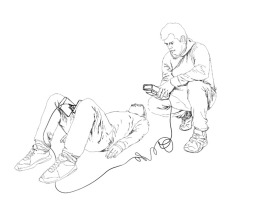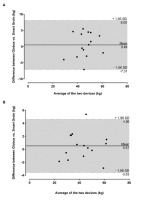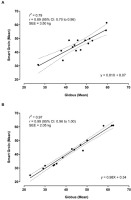Introduction
In sports contexts, hip adduction strength measures are helpful to identify athletes with a high risk of a groin injury and provide an objective result when assessing an athlete's ability to return to play (Thorborg et al., 2011; Tyler et al., 2001). Scientific evidence suggests that groin injuries are common in different sports that require quick changes of movement directions and consequently high levels of accelerations and decelerations, such as in ice hockey and soccer (Esteve et al., 2015; Fulcher et al., 2010; Tyler et al., 2010). Athletes with low levels of isometric hip adduction strength are more prone to develop injuries (Moreno-Pérez et al., 2017; Rodriguez, 2020; Ryan et al., 2014; Tyler et al., 2010). Therefore, measuring hip adduction strength during the season is essential to examine the athlete's needs and prescribe preventive strategies to avoid groin injuries (Tyler et al., 2010).
The force generated by the hip muscles can be measured using different methods, including isokinetic dynamometers, handheld dynamometers, and manual muscle testing (Keep et al., 2016; Meyer et al., 2013). Isokinetic and handheld dynamometers provide quantitative measures, while manual muscle testing offers a qualitative result, which might be more prone to measurement error than the former methods (Keep et al., 2016; Meyer et al., 2013; Nadler et al., 2000). Although isokinetic dynamometers are considered the reference criterion (Stark et al., 2011), they are expensive, non-portable, time-consuming and require large spaces (Martins et al., 2017; Romero-Franco et al., 2019). As an alternative, handheld dynamometers are portable, user-friendly, and cheaper than isokinetic dynamometers (Keep et al., 2016; Martins et al., 2017; Meyer et al., 2013). On the other hand, handheld dynamometers may lead to a lack of stabilization and small substantial changes in the starting position and can generate problems with the placement of the dynamometer (Keep et al., 2016). Nevertheless, several authors have considered handheld dynamometers valid and reliable devices to measure hip adduction strength (Thorborg et al., 2009). Therefore, using a portable dynamometer to measure maximal isometric hip adduction strength seems a valid and reliable option within several sports contexts.
A recent study analyzed the reliability of a portable dynamometer known as a Smart Groin Trainer to measure isometric hip adduction strength in twenty-five university students (Gonçalves et al., 2021). The results demonstrated good inter- and intra-device reliability (intra-class correlation coefficient [ICC] values between 0.89-0.94 and coefficient of variation [CV] values between 3-4%) for the maximal isometric hip adduction strength measured in a supine and a seated position. According to those authors, the Smart Groin Trainer presented reliability levels like those reported in previous studies, making it a reliable device to measure hip adduction strength in sports and rehabilitation contexts. In fact, a previous prospective cohort study with seventy-one elite soccer players used the Smart Groin Trainer device to assess the hip adductor strength and track the incidence of groin injury during a competitive season (Moreno-Pérez et al., 2019). In addition, Moreno-Pérez et al. (2019) reported high reliability and relatively low measurement error when using the Smart Groin Trainer device to assess the hip adduction strength through a soccer-specific test called a squeeze strength test.
Nevertheless, despite the findings mentioned above, to our best knowledge, no study has compared the validity and reliability of the Smart Groin Trainer with another portable dynamometer to measure isometric hip adduction strength. Therefore, comparing the results obtained with the Smart Groin Trainer with another portable dynamometer, such as the Globus Ergometer (Morouço et al., 2014; Neiva et al., 2011), will make it possible to infer the validity and accuracy of this device in different sports contexts.
In this sense, in the current research, we aimed to analyze the intra- and inter-device validity and reliability of the portable Smart Groin Trainer device to measure the isometric hip adduction strength in professional soccer players and university students. We hypothesized that the Smart Groin Trainer device would present high intra- and inter-device validity and reliability to measure the hip adduction strength in professional soccer players and university students.
Methods
Experimental Approach to the Problem
In this crossover study, we analyzed the intra- and inter-device validity and reliability of the Smart Groin Trainer to measure the isometric hip adduction strength during the squeeze strength test in professional soccer players and university students. Before testing, all participants underwent a familiarization session to learn the adductor squeeze strength test's correct technique. Following the familiarization session, participants performed twice the squeeze strength test using two devices. The first was the Smart Groin Trainer (NeuroExcellence, Braga, Portugal), and the second was the Globus Ergometer (Globus™, Codigné, Italy). The data collection was randomized between participants, and all performed the same number of repetitions. The testing sessions were performed in a university laboratory with a room temperature between 22 and 24º C.
Participants
Fifteen male professional soccer players from the 2nd main league of the country (age: 25.33±4.06 years; body mass: 78.71±10.35 kg; body height: 1.81±0.06 m) and fifteen male sport sciences students who regularly performed physical exercise (age: 21.60±1.76 years; body mass: 72.23±8.21 kg; body height: 1.77±0.08 m) volunteered to participate in this study. All participants were free of ankle, knee, or hip injury for the past six months, and none of them presented medical problems in the previous three months. They were instructed to avoid strenuous exercise at least two days before the testing session. All participants received detailed information regarding the study procedures and signed a written informed consent form. The Ethics Committee of the University of Beira Interior approved this study which followed the recommendations of the Declaration of Helsinki.
Procedures
Measurement equipment and data acquisition
The Smart Groin Trainer consists of a uniaxial load cell interfaced to a personal laptop through a 12-bit analog-to-digital data acquisition board and custom software. The device measures the applied force up to 4905 N at a sampling frequency of 100Hz (Gonçalves et al., 2021). The Globus Ergometer consists of a data acquisition system that can either export or exhibit the data recorded by a load cell. The load cell measures the exerted force up to 5000N at a sampling frequency of 100Hz (Morouço et al., 2014; Neiva et al., 2011). In both devices, the force data were presented in kg due to the fact that it is easier for coaches/teachers to understand.
Adductor Squeeze Strength Test
Testing sessions started with a general warm-up of 10 min, consisting of running at low to moderate intensity, followed by joint mobilization. Then, all participants performed the adductor squeeze strength test following the procedures described by Moreno-Pérez et al. (2019). They lay down on a mat in a supine position with 45⍛ hip flexion and 90⍛ knee flexion, and the dynamometer was placed between the knees and attached to the thighs with Velcro straps (Figure 1). A specific warm-up of three submaximal isometric hip adduction contractions lasting 5 s, interspersed by 30 s rest intervals, was conducted. After recovery, participants performed three maximal isometric hip adduction contractions ("squeeze the cuff as hard as possible") lasting 5s, followed by 3min rest intervals between the following attempts. Three valid measures with both dynamometers were averaged and registered for further analysis.
Statistical Analysis
The normality was verified using the Shapiro-Wilk test, histograms, and Q-Q plots, while the homogeneity of variances was tested using the Levene's test. Paired samples t-tests were used to verify whether a mean difference between devices existed. The Hedge's g effect size analyzed the magnitude of the differences between devices. The effect size was interpreted as: <0.2, trivial; 0.2-0.6, small; 0.6-1.2, moderate; 1.2-2.0, large; 2.0-4.0, very large; >4.0, extremely large (Hopkins et al., 2009). Bland-Altman plots with 95% limits of agreement (LOA) were used to illustrate the two devices' systematic differences (Sainani, 2017). The relative reliability was assessed using the ICC with a 95% confidence interval. The type of the ICC used was the two-way random-effects, absolute agreement, multiple raters/measurements model [ICC(2,k)] (Koo and Li, 2016). ICC values were interpreted as: <0.50, poor; 0.50-0.75, moderate; 0.75-0.90, good; >0.90, excellent (Koo and Li, 2016). The linear regression and Pearson's correlation coefficients (r) analyzed the concurrent validity between devices. The magnitude of correlation was interpreted as: 0.00-0.10, negligible; 0.10-0.39, weak; 0.40-0.69, moderate; 0.70-0.89, strong; 0.90-1.00, very strong (Schober et al., 2018). The standard error of the estimate was calculated as the standard deviation (SD) of the residuals. The absolute reliability was analyzed by estimating the standard error of measurement (SEM) and the CV. The inter-device SEM was calculated as the SD of the difference between devices divided by the √2 (de Vet et al., 2011). The intra-device SEM was calculated as the SD of the mean of the three repetitions x √1-ICC (Sainani, 2017). The CV (%) was calculated as the SEM divided by the mean. CV values were interpreted as: >10%, poor; 5-10%, moderate; <5%, good (Scott et al., 2016). The sensitivity to change was estimated using the minimal detectable change (MDC) derived from the SEM (√2 x SEM x 1.96) (Sainani, 2017). The absolute percent error (APE = ((|Smart Groin Trainer – Globus Ergometer)/Globus Ergometer|) x 100), and accuracy ((Globus Ergometer – (|Globus Ergometer – Smart Groin Trainer|)/Globus Ergometer) x 100) were also calculated. An APE value <10% was considered acceptable (Montoye et al., 2017). Statistical analyses were performed in SPSS v27 (SPSS Inc., Chicago, USA) and Microsoft Office Excel. Figures were designed using GraphPad Prism 7.0 (GraphPad Software Inc., California, USA).
Results
Inter-device magnitude of differences
We did not observe significant differences between devices in the squeeze strength test's mean values in soccer players and university students (Table 1).
Table 1
Magnitude of inter-device differences in the measurement of isometric hip adduction strength.
The Bland-Altman plots are presented in Figure 2.
Inter-device reliability and accuracy
Table 2 presents the inter-device reliability and accuracy in the measurement of the isometric hip adduction strength. The ICC data revealed excellent inter-device relative reliability, and CV values moderate and excellent inter-device absolute reliability in soccer players and university students, respectively. The highest MDC was recorded for soccer players. In both cases, the APE was lower than 10%, representing an acceptable measurement error, and the accuracy was higher than 92%, thus revealing a high accuracy level.
Table 2
Inter-device reliability and accuracy in the measurement of isometric hip adduction strength.
| Soccer Players (n = 15) | Students (n = 15) | |
|---|---|---|
| ICC (95% CI) | 0.94 (0.83-0.98) | 0.99 (0.98-1.00) |
| SEM (kg) | 2.71 | 1.46 |
| CV (%) | 5.90 | 3.45 |
| MDC (kg) | 7.51 | 4.05 |
| APE (%) | 7.51 | 4.08 |
| Accuracy (%) | 92.49 | 95.92 |
The regression models for the two groups are presented in Figure 3. The correlation between devices was strong in soccer players and very strong in university students.
Intra-device reliability
Table 3 presents the intra-device reliability in the measurement of the isometric hip adduction strength. The ICC revealed excellent relative reliability in soccer players, and the CV showed good absolute reliability using both devices. The MDC was higher in the Globus device than the Smart Groin Trainer. The ICC revealed excellent relative reliability in university students using both devices, and the CV presented good absolute reliability. The MDC was higher in the Smart Groin Trainer than in the Globus device.
Table 3
Intra-device reliability in the measurement of isometric hip adduction strength.
Discussion
The current research examined the intra-and inter-device validity and reliability of the portable Smart Groin Trainer dynamometer to measure isometric hip adduction strength in professional soccer players and university students during the squeeze test. Our results demonstrated that the Smart Groin Trainer device is valid and reliable for measuring the adductors' strength during the squeeze test, confirming our hypothesis. Therefore, our data suggest the Smart Groin Trainer as a valuable portable device for professional and recreational sports to measure hip adduction strength during the squeeze test.
Previous studies determining the relative reliability of dynamometers to measure hip adduction strength in a supine position observed ICCs from 0.76 to 0.98 when using handheld dynamometers (Kelln et al., (2008), ICC: 0.77 to 0.97; Mentiplay et al., (2015), ICC: 0.84 to 0.98; Thorborg et al., (2009), ICC: 0.76 to 0.98), and ICCs from 0.79 to 0.93 when using an isokinetic dynamometer (Meyer et al., 2013). Therefore, taken together, these results suggest that both devices provide high relative reliability values when measuring hip adduction strength in a supine position. In fact, a previous metanalysis aiming to determine the reliability between isokinetic and handheld dynamometers to measure the force production during different types of joint movements observed ICC values ranging from 0.91 to 0.98 for hip adduction strength measured in a supine position (Chamorro et al., 2017).
Nevertheless, despite the findings mentioned above, to our knowledge, only one study has analyzed the relative reliability of the Smart Groin Trainer to measure hip adduction strength in a supine position (Gonçalves et al., 2021). In that study, the authors observed an ICC value of 0.94 (0.86-0.97) for the maximal isometric hip adduction contraction (N), which is similar to values presented in our research for the intra-device analysis. Our analysis also demonstrated that the Smart Groin Trainer presented high inter-device relative reliability to measure hip adduction strength in professional soccer players and university students. The high ICCs were accompanied by high accuracy values, low APE results, and strong to very strong relationships between devices. Therefore, as stated for handheld and isokinetic dynamometers, a portable and stabilized dynamometer (i.e., that "fixes" or "stabilizes" the load sensor in the assessed muscle region) presents high relative reliability, accuracy, and validity to measure hip adduction strength during the squeeze test.
The intra-device analysis demonstrated small SEM and CV values when using the Smart Groin Trainer. The CV results are similar to those presented in previous research that used the same device to measure the maximal isometric hip adduction contraction (N) in a supine position (Gonçalves et al., 2021). Similar values of absolute reliability were also observed in studies which measured hip adduction strength in a supine position using handheld dynamometers (Kelln et al., 2008; Mentiplay et al., 2015; Thorborg et al., 2009) or an isokinetic dynamometer (Meyer et al., 2013). Besides these results, our study also demonstrates that the SEM and CV data extracted from the comparisons between devices confirm the Smart Groin Trainer's excellent reliability to measure hip adduction strength during the squeeze test. It is essential to notice that the latter test is highly used in soccer contexts due to its high validity and reliability to diagnose groin injuries (Delahunt et al., 2011; Moreno-Pérez et al., 2019). Therefore, using the Smart Groin Trainer during the squeeze strength test might be a valid and reliable strategy to identify athletes with a high risk of groin injuries and monitor changes in adductor strength over the season (Moreno-Pérez et al., 2019).
This study has some limitations that must be considered. Firstly, it is worth mentioning that the study sample does not enable us to generalize the results to other athletic populations. Secondly, the homogeneity of players considering their different playing positions was not taken into account because it could cause increased levels of variability in the final results. Thirdly measuring hip abduction strength would allow us to examine the Smart Groin Trainer's inter-device reliability and analyze the hip adductor to abductor strength ratio. Fourthly, measuring kinetic variables such as the rate of force development over different periods would help us analyze the Smart Groin Trainer's inter-device reliability. Finally, recruiting athletes of various sports with different hip strength levels would be essential to examine the dynamometer's reliability to identify these differences. Therefore, future studies should recruit a broad spectrum of sports athletes to examine the Smart Groin Trainer device's validity and reliability to measure isometric hip adduction and abduction strength and other mechanical variables.
Conclusion
Our results revealed that the Smart Groin Trainer device is valid and accurate to measure isometric hip adduction strength in professional soccer players and university students. This device can be used in clinical and sports contexts to measure isometric hip adduction strength during the squeeze strength test and hip strength changes during the training and rehabilitation process. In addition, the Smart Groin Trainer’s features (portable, small, and easy-to-use) make it a suitable device to be used by coaches and researchers in the sports field.





